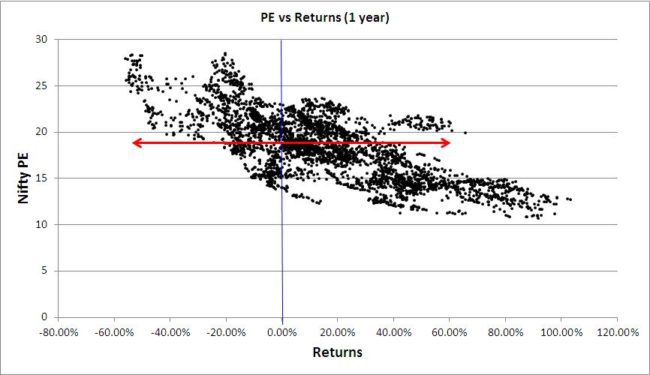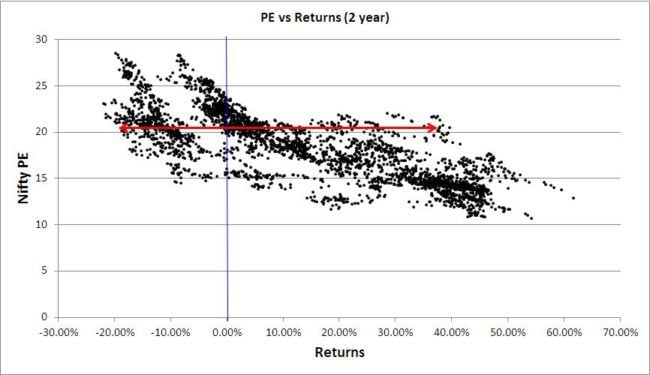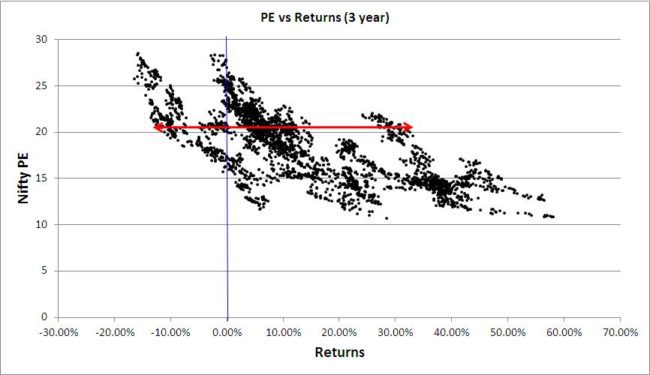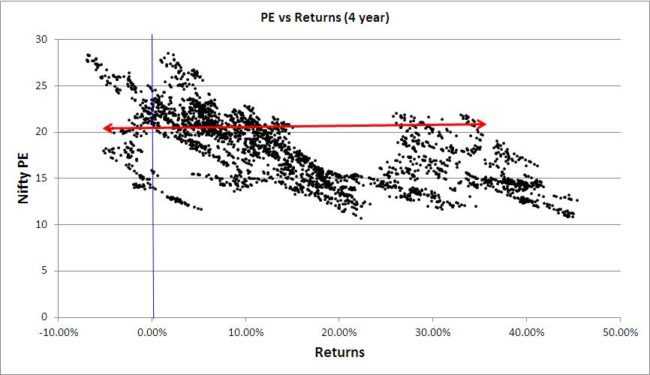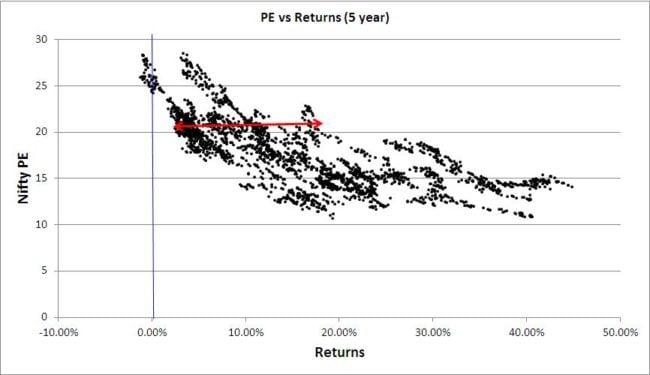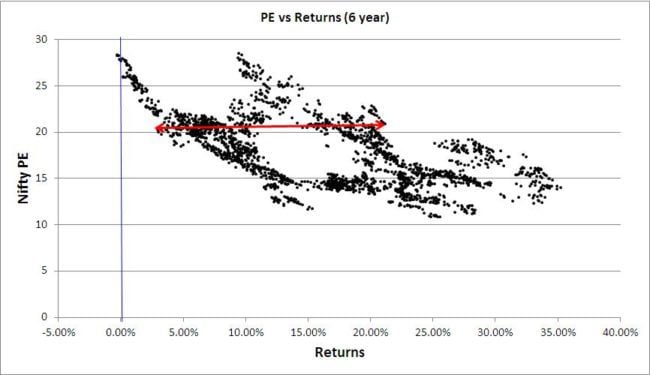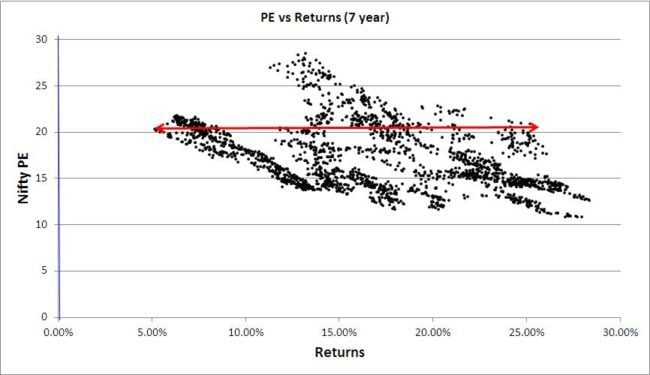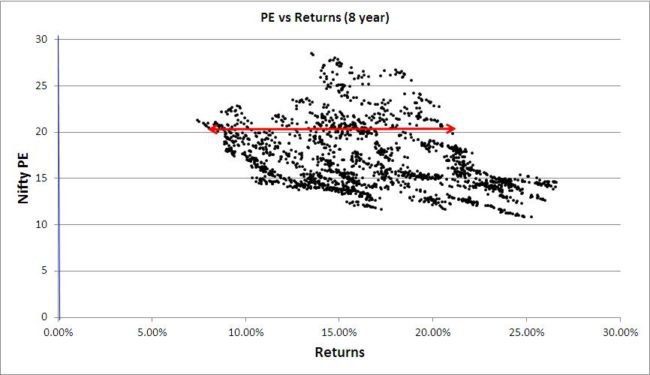Last Updated on September 4, 2018 at 9:49 am
Ever since I introduced the concept of SI-PE (PE based SIP investing) in the post, ‘Are Mutual Fund SIPs Suitable for Disciplined Long-Term Investors?‘, I have been worried because it instantly struck a chord with many readers.
SI-PE refers to manual investment based on the PE value of an established index. If the PE is greater than 20 (value chosen arbitrarily! ), monthly investments are put on hold. All the uninvested amount is invested in one go when PE drops below 20.
In the same post, it was shown that a SIP (blind monthly investing regardless of the state of the market) works perfectly for the long term investor. SI-PE scores over the SIP but only by a little.
Since then I have received many questions on the SI-PE, leaving me worried.
Join 32,000+ readers and get free money management solutions delivered to your inbox! Subscribe to get posts via email! (Link takes you to our email sign-up form)
🔥Want to create a complete financial plan? Learn goal-based investing? Exclusive access to our DIY tools? Increase your income with your skills? Use this link to enjoy massive discounts on our robo-advisory tool & courses! 🔥
Is the Nifty PE really relevant for the long-term investor? Of course, if I invest when the PE is 28 and look at my holding a year later, I am almost certain to have lost money. What if I chose not to touch my holding? What if I held on to it for say, 10 years?
Would it still make a difference?
In this post, let us try and answer this question. I present below a series of plots of the Return obtained versus Nifty PE corresponding to the investment date for durations ranging from 1Y to 13y. The data was obtained with the rolling returns calculator. Nifty closing values and PE from 1st Jan 1999 to 30th June 2014 were used for the analysis
If you need the Excel sheet, leave a comment.
These plots are wonderful examples of market volatility. So I suggest you stare at them for long periods of time!
1-year
The vertical blue line represents 0% returns! The horizontal red line represents the range of returns possible for a give PE value. For example, the current Nifty PE is a little less than 21. So if you invest a sum now, the return after a year could range from -50% to +60%. Just about anything.
However, if the PE was 25 or more, The return is likely to be negative (-50% to -10%).
Interestingly if the PE was close to 10, the return can still vary by a huge margin (+30% to +90%)
Notice that the bunch of points slope down from the top left to the bottom right of the graph. This is referred to as a negative correlation: Higher the PE, lower the return. The width of the bunch represents the extent of correlation. That is, if the range of returns possible at a given PE is narrow, the (negative)correlation is strong.
2-year
Notice the range or returns possible for current PE levels (red line). Again just about anything. Higher the PE, lower the return, but the range of returns has increased.
3-year
Notice that the bunching has disintegrated. The points have spread out and the negative correlation has reduced. Returns for a sum invested 3 years ago at a PE ~ 11 can just about be anything, 5% to 60%! Investing at high PE levels still implies a negative return.
4-year
The negative correlation has lowered further. The range of returns possible for investing at low PE has increased 🙁
Notice that the bunch of points is moving toward the right – more positive returns.
5-year
The bunch has now moved almost entirely in the positive region. Surprisingly the negative correlation has strengthened now. That is the bunching is tighter now. If one invests at a PE level of 25 and above, it would take about 5 years to get a small but positive return!
So the case for not investing at high PE levels is very much alive!
Surprisingly the case for investing at low PE levels comes tagged with a huge spread in the possible ‘high’ returns.
6-year
The plot looks like a swordfish! Again the bunching has reduced for low and medium PE values. The bunching is tight at high PE levels (the sword!)
8-year
The bunching has reduced again! Investing at PE levels of 15 and lower has very high chance of getting a double-digit return. Not enough high PE level data points. Whatever exists completely contradicts the high-PE equals low-return theory!!
10-year
The bunching and negative correlation returns!
12-year
The correlation is stronger, but the number of data points have reduced significantly. Those who invested at PE levels of 25 and above, 12 years back would be sitting with a return of about 10%, while those who invested with Nifty PE less than 15 would have got about 15% or more.
Whether this is significant or not can be debated endlessly. As mentioned above, the case for not investing at high PE (~ 25) remains strong enough, whereas the case for investing only at low PE (< 15) has weakened, thanks to the wide range of returns possible.
Should one forget about all this and just do a mutual fund SIP? Not a bad idea at all.
Is SI-PE worth it? well, yes and no.
Yes it makes sense not to invest when the PE is high. Yes it even makes sense to pull out a portion of the equity corpus when the PE is very high (> 25).
However, it also makes sense to get rid of the salary into an investment each month. So perhaps one can have a base SIP running and ‘time’ the additional amount according to the PE. Perhaps.
It all comes down to ones mental framework. If one can remain cool, calm and stop worry about the grass on the other side of the meadow, SI-PE will work.
If one gets worked up each time the PE increases by a few points, SI-PE is not worth it.
I do monthly manual investing and do try to invest on 1-2% market dips each month.
On the one hand, my monthly investment is high and my portfolio is getting fatter, meaning soon it will swing by 60K-100K over a few days if not over a day. So I cannot simply invest more or let the money lie around when the PE is high. I however have a lot of inertia and will not do this impulsively.
On the other hand, I am an investment junkie. Unless I put away my salary as soon as possible, I will feel restless. The money may or may not get spent, but I will quite uneasy. So I will need to balance this.
What I do may or may not be smart. It is my thing. You will have to figure out yours. If you are a ‘new’ investor stick to a SIP!

Use our Robo-advisory Tool to create a complete financial plan! ⇐More than 3,000 investors and advisors use this! Use the discount code: robo25 for a 20% discount. Plan your retirement (early, normal, before, and after), as well as non-recurring financial goals (such as child education) and recurring financial goals (like holidays and appliance purchases). The tool would help anyone aged 18 to 80 plan for their retirement, as well as six other non-recurring financial goals and four recurring financial goals, with a detailed cash flow summary.
🔥You can also avail massive discounts on our courses and the freefincal investor circle! 🔥& join our community of 8000+ users!
Track your mutual funds and stock investments with this Google Sheet!
We also publish monthly equity mutual funds, debt and hybrid mutual funds, index funds, and ETF screeners, as well as momentum and low-volatility stock screeners.
You can follow our articles on Google News

We have over 1,000 videos on YouTube!

Join our WhatsApp Channel



- Do you have a comment about the above article? Reach out to us on Twitter: @freefincal or @pattufreefincal
- Have a question? Subscribe to our newsletter using the form below.
- Hit 'reply' to any email from us! We do not offer personalised investment advice. We can write a detailed article without mentioning your name if you have a generic question.
Join 32,000+ readers and get free money management solutions delivered to your inbox! Subscribe to get posts via email! (Link takes you to our email sign-up form)
About The Author
 Dr M. Pattabiraman (PhD) is the founder, managing editor and primary author of freefincal. He is an associate professor at the Indian Institute of Technology, Madras. He has over 13 years of experience publishing news analysis, research and financial product development. Connect with him via Twitter(X), LinkedIn, or YouTube. Pattabiraman has co-authored three print books: (1) You can be rich too with goal-based investing (CNBC TV18) for DIY investors. (2) Gamechanger for young earners. (3) Chinchu Gets a Superpower! for kids. He has also written seven other free e-books on various money management topics. He is a patron and co-founder of “Fee-only India,” an organisation promoting unbiased, commission-free, AUM-independent investment advice.
Dr M. Pattabiraman (PhD) is the founder, managing editor and primary author of freefincal. He is an associate professor at the Indian Institute of Technology, Madras. He has over 13 years of experience publishing news analysis, research and financial product development. Connect with him via Twitter(X), LinkedIn, or YouTube. Pattabiraman has co-authored three print books: (1) You can be rich too with goal-based investing (CNBC TV18) for DIY investors. (2) Gamechanger for young earners. (3) Chinchu Gets a Superpower! for kids. He has also written seven other free e-books on various money management topics. He is a patron and co-founder of “Fee-only India,” an organisation promoting unbiased, commission-free, AUM-independent investment advice.Our flagship course! Learn to manage your portfolio like a pro to achieve your goals regardless of market conditions! ⇐ More than 3,500 investors and advisors are part of our exclusive community! Get clarity on how to plan for your goals and achieve the necessary corpus no matter the market condition!! Watch the first lecture for free! One-time payment! No recurring fees! Life-long access to videos! Reduce fear, uncertainty and doubt while investing! Learn how to plan for your goals before and after retirement with confidence.
Increase your income by getting people to pay for your skills! ⇐ More than 800 salaried employees, entrepreneurs and financial advisors are part of our exclusive community! Learn how to get people to pay for your skills! Whether you are a professional or small business owner seeking more clients through online visibility, or a salaried individual looking for a side income or passive income, we will show you how to achieve this by showcasing your skills and building a community that trusts and pays you. (watch 1st lecture for free). One-time payment! No recurring fees! Life-long access to videos!
Our book for kids: “Chinchu Gets a Superpower!” is now available!


Must-read book even for adults! This is something that every parent should teach their kids right from their young age. The importance of money management and decision making based on their wants and needs. Very nicely written in simple terms. - Arun.Buy the book: Chinchu gets a superpower for your child!
How to profit from content writing: Our new ebook is for those interested in getting a side income via content writing. It is available at a 50% discount for Rs. 500 only!
Do you want to check if the market is overvalued or undervalued? Use our market valuation tool (it will work with any index!), or get the Tactical Buy/Sell timing tool!
We publish monthly mutual fund screeners and momentum, low-volatility stock screeners.
About freefincal & its content policy. Freefincal is a News Media organisation dedicated to providing original analysis, reports, reviews and insights on mutual funds, stocks, investing, retirement and personal finance developments. We do so without conflict of interest and bias. Follow us on Google News. Freefincal serves more than three million readers a year (5 million page views) with articles based only on factual information and detailed analysis by its authors. All statements made will be verified with credible and knowledgeable sources before publication. Freefincal does not publish paid articles, promotions, PR, satire or opinions without data. All opinions will be inferences backed by verifiable, reproducible evidence/data. Contact Information: To get in touch, please use our contact form. (Sponsored posts or paid collaborations will not be entertained.)
Connect with us on social media
- Twitter @freefincal
- Subscribe to our YouTube Videos
- Posts feed via Feedburner.
Our publications
You Can Be Rich Too with Goal-Based Investing
 Published by CNBC TV18, this book is designed to help you ask the right questions and find the correct answers. Additionally, it comes with nine online calculators, allowing you to create custom solutions tailored to your lifestyle. Get it now.
Published by CNBC TV18, this book is designed to help you ask the right questions and find the correct answers. Additionally, it comes with nine online calculators, allowing you to create custom solutions tailored to your lifestyle. Get it now.Gamechanger: Forget Startups, Join Corporate & Still Live the Rich Life You Want
 This book is designed for young earners to get their basics right from the start! It will also help you travel to exotic places at a low cost! Get it or gift it to a young earner.
This book is designed for young earners to get their basics right from the start! It will also help you travel to exotic places at a low cost! Get it or gift it to a young earner.Your Ultimate Guide to Travel
 This is an in-depth exploration of vacation planning, including finding affordable flights, budget accommodations, and practical travel tips. It also examines the benefits of travelling slowly, both financially and psychologically, with links to relevant web pages and guidance at every step. Get the PDF for Rs 300 (instant download)
This is an in-depth exploration of vacation planning, including finding affordable flights, budget accommodations, and practical travel tips. It also examines the benefits of travelling slowly, both financially and psychologically, with links to relevant web pages and guidance at every step. Get the PDF for Rs 300 (instant download)